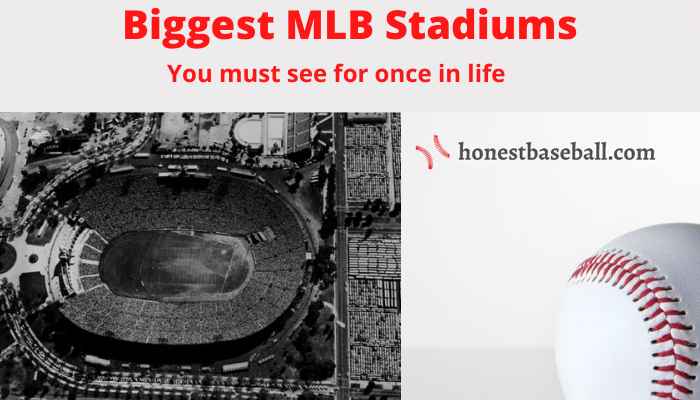Do you know what it is about baseball that makes it so popular in so many different countries? Baseball features some of the Biggest MLB Stadium in addition to its spectacular gameplay.
Baseball has the power to unite people from all walks of life. It has been shown that teams perform better when they feel as though hundreds of thousands of people are rooting for them. This fantastic game is enjoyed by players from all around the world.
Baseball originated in the United States. When it comes to professional sports leagues, there is nothing new.
Big baseball games have taken place all around the United States of America. Major League Baseball (MLB) clubs play in 30 venues. Major League Baseball’s 30 Biggest MLB stadiums and Minor League and vintage venues are included in MLB The Show 22.
Each baseball stadium has unique dimensions, whereas other sports have identical field measurements. There are several elements to consider when choosing a stadium to perform in The Show, including your favorite team, hometown, special memories, and more.
Major League Baseball Stadiums
Fans are lured to different ballparks because each one offers a unique combination of ambiance and entertainment options, which keeps them coming back. MLB boasts some of North America’s most recognizable sports teams and some of the world’s most beautiful venues, and these franchises have built them.
Which stadiums, however, stand out from the crowd? Since I am a baseball fan and a coach, I have been to numerous MLB stadiums, and therefore I have listed here some biggest MLB Stadiums by capacity.
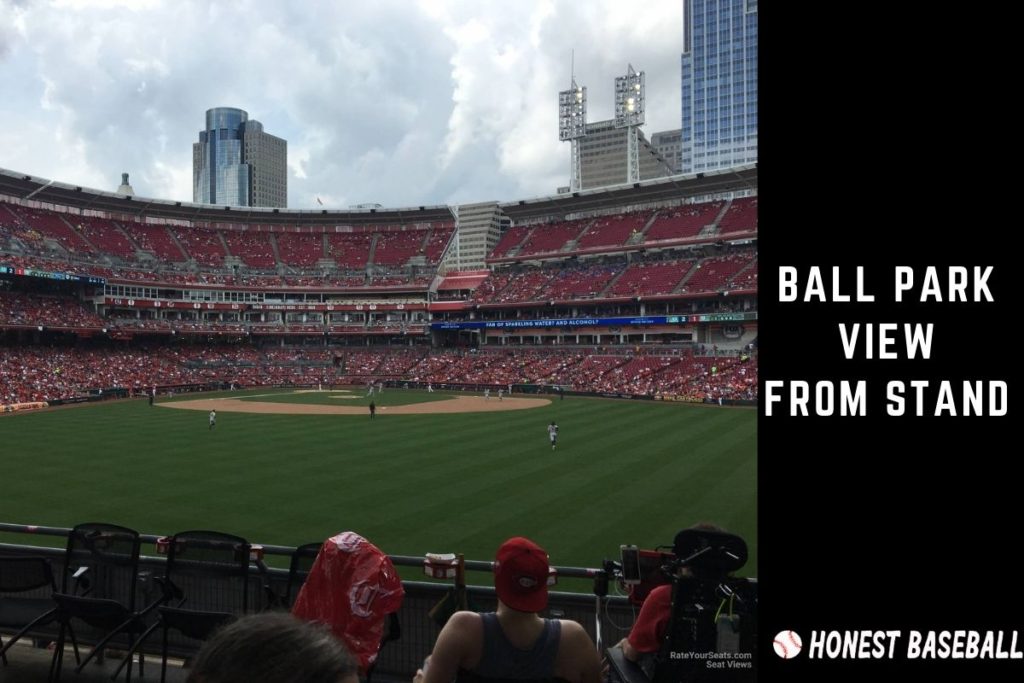
Oakland Coliseum
Location: Oakland, California
Opened: 1966
Team: Oakland Athletics
Seating Capacity: 63,132
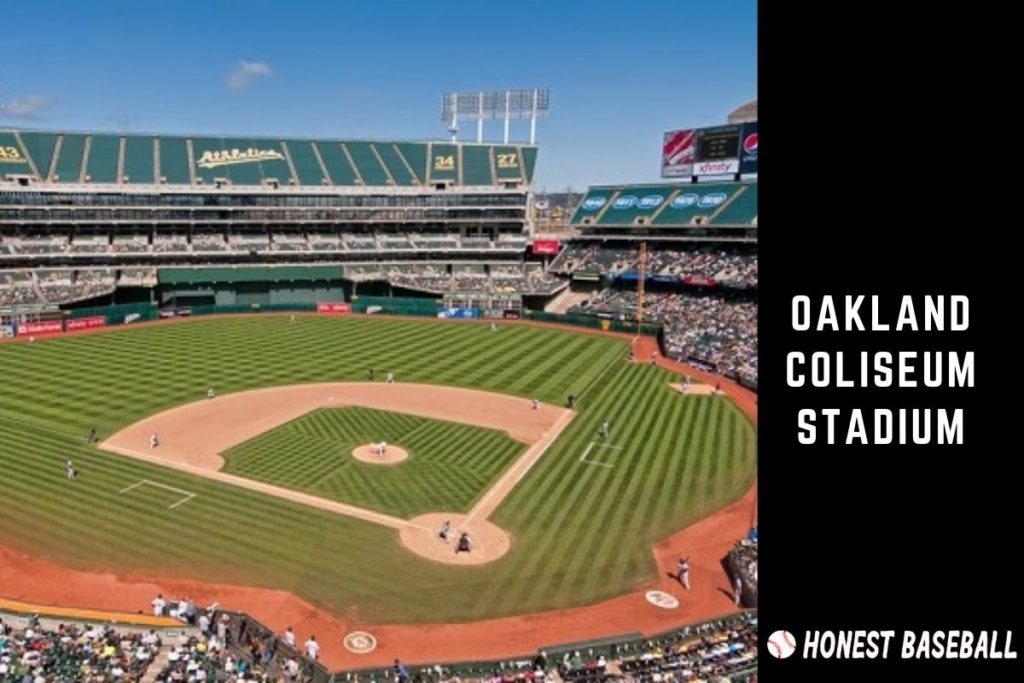
The Coliseum is baseball’s bland ballpark. Former football stadium constructed in 1966 that is seldom more than half-full nowadays. However, there is a certain allure about that outfield.
The retractable seats in the multifunctional stadium allow the barriers in the left and right center to raise to 15 feet. Oakland is a great place to hit triples at the price of home runs.
Fans have called the upper deck of the Coliseum “Mount Davis” since it was built in 1996 as part of a refurbishment for the homecoming of the Oakland Raiders. A total of 6,300 club seats and 143 high-end suites are available. Except for a high-voltage match, getting you a seat will be no trouble.
Rickey Henderson, a former Oakland Athletic and MLB Hall of Famer, was honored with the distinction of having his name placed on the field. In my opinion, the Oakland Coliseum is a terrible venue. In May 2019, the Oakland Coliseum was rebranded as RingCentral Coliseum for three years.
Dodger Stadium
Location: Los Angeles, California
Opened: 1962
Team: Los Angeles Dodgers
Seating Capacity: 56,000
Nothing else in baseball compares to being at Dodger Stadium with views of the surrounding San Gabriel Mountains and palm trees in the backdrop. Once again, the new electronic infrastructure at Dodger Stadium will provide fans with an entirely new in-stadium environment for one of Major League Baseball’s most devoted teams.
There is not a single item you will not find in the Los Angeles Dodgers’ new stadium. Center-field concourse at Chavez Ravine has two medium-sized giant screens instead of a single one that covers half the outfield.
Despite being a large stadium, it has crowded concourses that do not keep many spectators too far from the action. Even the grass is greener in L.A., producing a gem of a stadium that has endured the test of time.
The Dodgers have the second-largest capacity in the globe at 56,000. Initially, the team was based out of Ebbets Field in Brooklyn, NY, where they played for 44 seasons.
Dodger Stadium has an atmosphere that is hard to replicate in baseball. Even though it is over 50 years old, it is still one of the best ballparks in MLB.
Dodger Stadium has maintained its status as one of the US’s most pristine and gorgeous ballparks. Additionally, the team hires a full-time arborist to maintain and beautify the landscape around the stadium.
Considering that Dodger Stadium was originally intended to hold 75,000 people, it is surprising that the views from beyond the outfield have been lost.
You might wonder what is so great about Dodger Stadium. The Dodgers have won five World Series titles at those venues, which have hosted a total of ten World Series. The Dodger Stadium is sure to bring back some fond memories for long-time baseball fans.
The stadium’s original designs also featured a beautiful fountain in the center field. It’s different-colored lighting flashing on the falling waters whenever a Dodger player hits a home run.
Simply going to this stadium will provide you with a whole different experience for you. In this stadium, the chants of the baseball players are audible, and the atmosphere is magnificent.

Rogers Centre
Location: Toronto, Ontario
Opened: 1989
Team: Toronto Blue Jays
Seating Capacity: 49,282
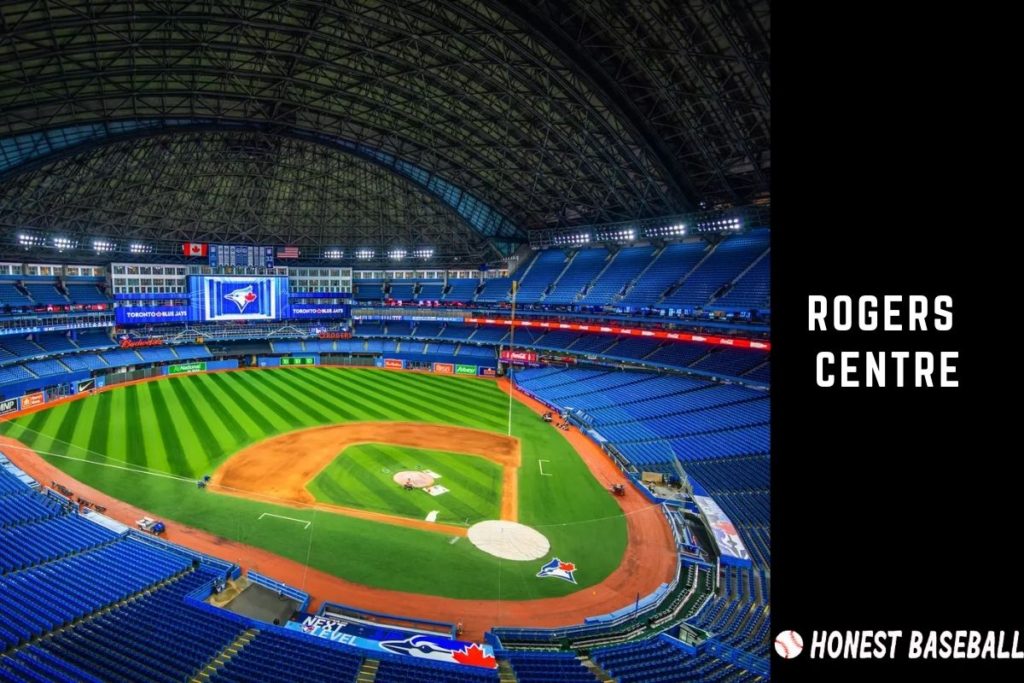
The only ballpark on this list that is not placed inside the United States of America is the Rogers Centre. A technical wonder, the ballpark’s design and location in the center of downtown Toronto delighted me.
The Rogers Centre is one of the biggest stadiums in Canada, including over 49,000 seats, and it has played home to more than 200 different events during the year. This baseball stadium was elected in 1989 to host the Toronto Blue Jays and has a retractable roof to keep out the severe Canadian winters.
The concrete structure is outstanding even though it does not possess the vintage charm of some of the other ballparks and is not at all gleaming and contemporary. It is situated so close to the foot of the CN Tower that it offers an excellent additional draw for travelers.
The walkway was lovely, and I appreciate how you can watch the action on the field no matter where you are when walking around the main concourse. Even when the roof was shut, it was an excellent venue to watch a match.
The seats were quite cramped, and there was almost no space for my legs. This made the experience very unpleasant. Even the team store was underwhelming, with limited selection and an unappealing appearance.
Yankee Stadium
Location: Bronx, New York
Opened: 2009
Team: New York Yankees
Seating Capacity: 47,309
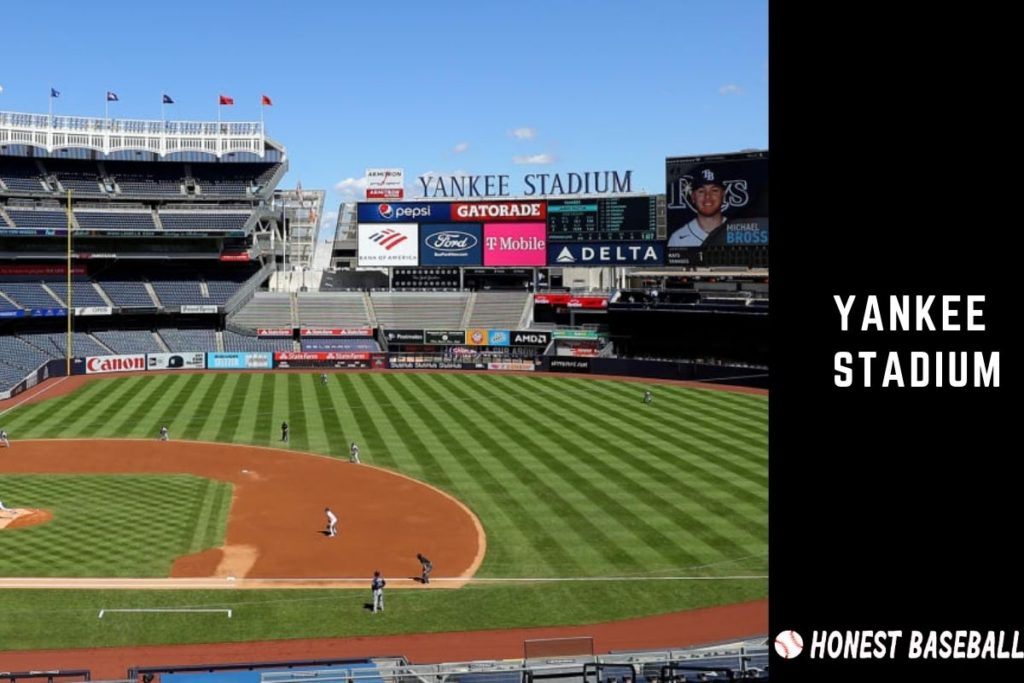
Yankee Stadium For eight decades, Yankee Stadium hosted some of the greatest moments in baseball history. How can you replace this historic site? With a construction budget of $2.7 billion, Yankee Stadium is the most costly MLB venue.
Yankee Stadium is a near-exact recreation of the old Yankee Stadium and is directly across the street! However, they made it larger, more luxurious, and more expensive. There is no way the new Yankee Stadium can ever be an exact reproduction of the old one, but it still makes for an excellent place to watch a game. You do not want to miss Monument Park in center-field.
New York City is home to Yankee Stadium. The 48,316 fans who saw Derek Jeter’s spectacular inside-out swing in the Yankees’ victory against the Orioles will never forget it.
There have been few improvements to the stadium since its inauguration. Yankee Stadium had a major renovation before the 2017 season’s opening game.
A $20 million makeover removed 1,100 obstructed-view bleacher seats and 600 from the Terrace Level. The Budweiser Party Decks and the Batter’s Eye Cafe are among the meeting and gathering areas that have taken the place of the bleachers.
Coors Field
Location: Denver, Colorado
Opened: 1995
Team: Colorado Rockies
Seating Capacity: 50,398
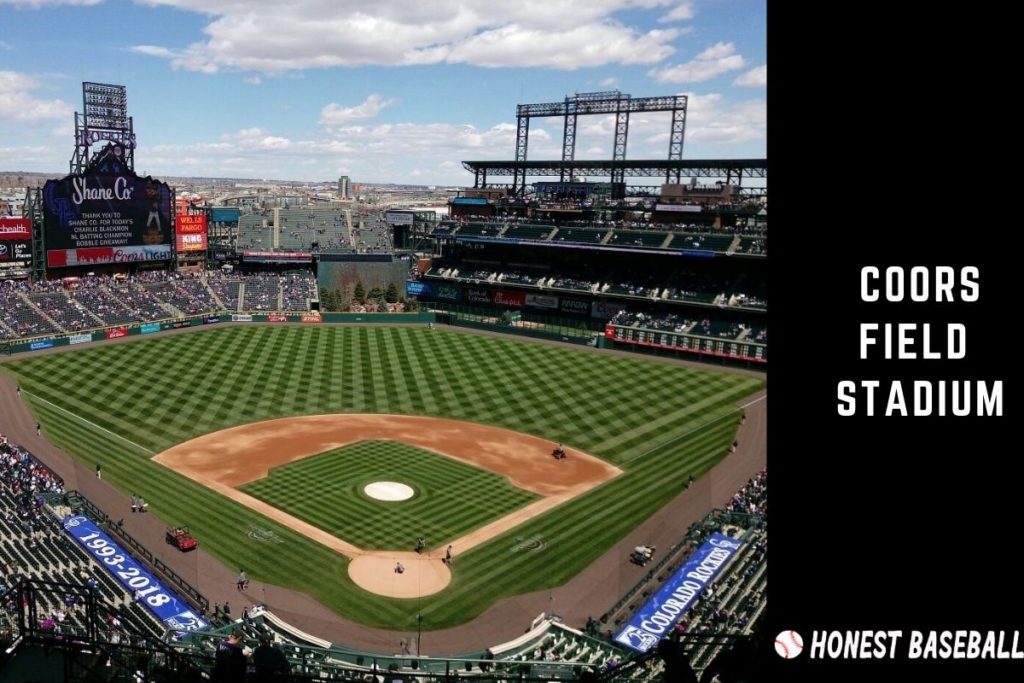
Coors Field, in my opinion, is one of the best ballparks in the country. With its brick and steel architecture, it blends in well with the historic structures in Denver’s downtown area. The Colorado Rockies play at Coors Field, the nation’s third-largest baseball stadium.
The original design for Coors Field called for a seating capacity of 43,800. Last season, the Rockies broke the record at Mile High Stadium and drew 49,469 fans.
The Rockies built Mile High Stadium too large in response to the huge crowds they attracted during their first two seasons, so they transformed the third deck into a party zone.
Relax. Most purple seats are still on the top floors, which is named so because it is 5,280 feet above sea level.
Because of Denver’s thinner air, Coors Field has historically functioned as a hitter’s field, and the same factors carry over into the game.
This is because the ball flies at altitude, which reduces home runs but increases the number of triples at the Coors Fields. Coors Field is a refreshing anomaly, but it would be irritating if MLB had such a lot more parks like it. Left-handed hitters have difficulty hitting a home run into left field, and many balls are likely to fly out of the park in this area.
Chase Field
Location: Downtown Phoenix, Arizona
Opened: 1998
Team: Arizona Diamondbacks
Seating Capacity: 48,686
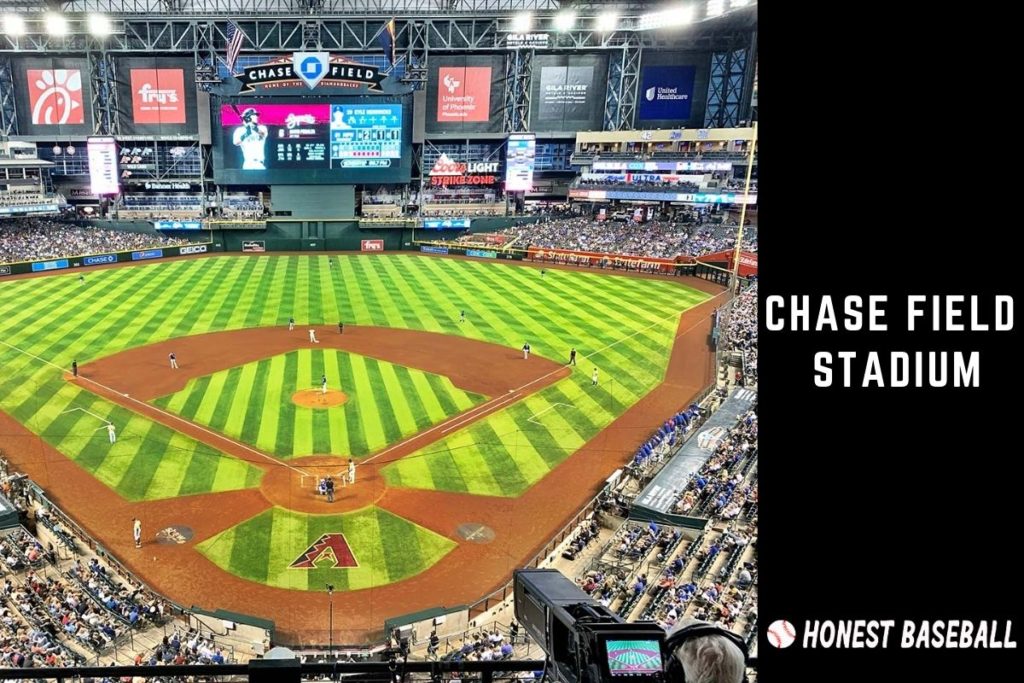
Fans often think of “the swimming pool” as the first image that comes to mind when they hear the name Chase Field. Chase Field was ultimately finished in 1998, years after the project had sparked controversy and caused the government much grief. The city’s finances deteriorated, and the venue’s construction cost more than initially anticipated.
The chase field is vast. I mean, it is visible even from above in an aircraft.
The center wall of Chase Field is 25 feet high. Since Arizona’s centerfield is so large, it is the most triple-prone venue in Major League Baseball. Triplets are also a blast!
Chase Field’s architecture, layout, and feel are similar to those of Miller Park. For the 2019 season, the Arizona Diamondbacks changed the grass field at their stadium to a synthetic field. The retractable roof was the first of its kind to be installed in a ballpark when Chase Field was constructed.
It is a pity since it is a pretty attractive location if you can ignore everything else and concentrate on the playing area and the bottom seating bowl. It is difficult to filter out the rest of the world and focus on the game.
T Mobile Park
Location: Seattle, Washington
Opened: 1999
Team: Seattle Mariners
Seating Capacity: 47,476
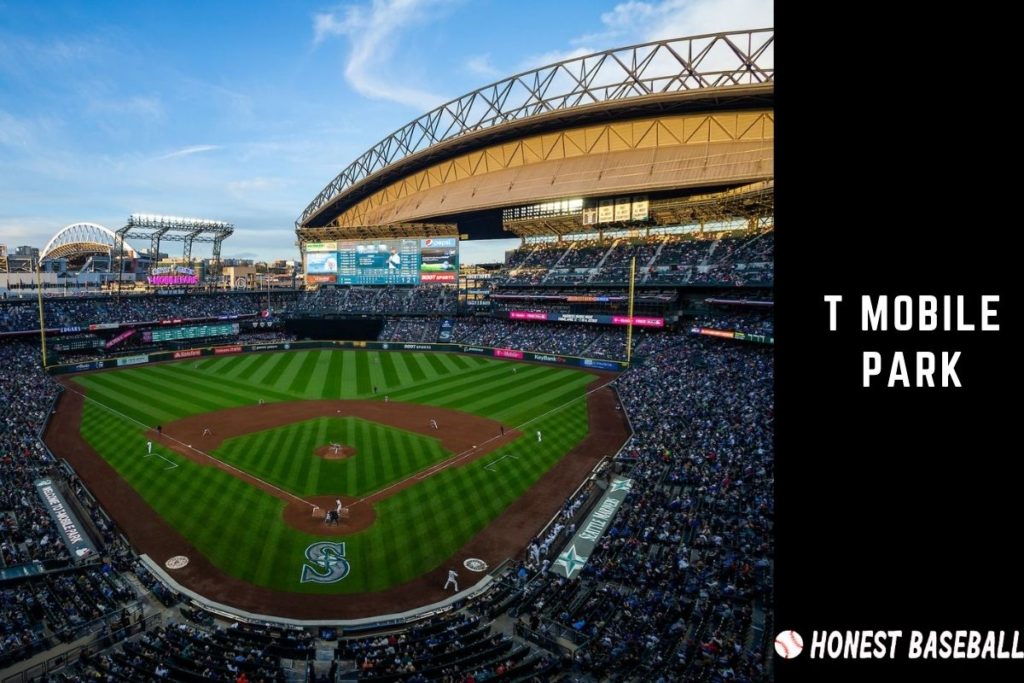
T-Mobile Park’s original name was Safeco Field. In December 2018, T-Mobile bought the rights to the trademark, and in January 2019, the company changed its name to T-Mobile Park.
For whatever reason, T-Mobile Park is everyone’s favorite baseball stadium. According to club executives, designers, and Mariner broadcasters, the finest stadium ever designed.
T-Mobile Park’s retractable roof is the most differentiating feature from other MLB stadiums. When it rains, the stadium’s retractable roof is activated; however, it does not cover the full field.
This gives the impression that you are really outside. A squad that has not reached the playoffs in over two decades may find the stadium a little intimidating.
T-Mobile Park has five tiers of seating, including two rows of bleachers in the center field. The Seattle skyline may be seen from the higher floors. After Safeco refused to extend the naming rights agreement, the stadium was renamed Safeco Field.
Since then, the Mariners have increased the distance of the fences in that area by up to 17 feet, which has resulted in more home runs, even though T-Mobile remains a pitcher-friendly stadium. However, since right-handers have more freedom to work in the center field than left-handers, the righties continue to rack up more three-pointers.
Angel Stadium
Location: Anaheim, California
Opened: 1966
Team: Los Angeles Angels
Seating Capacity: 45,517
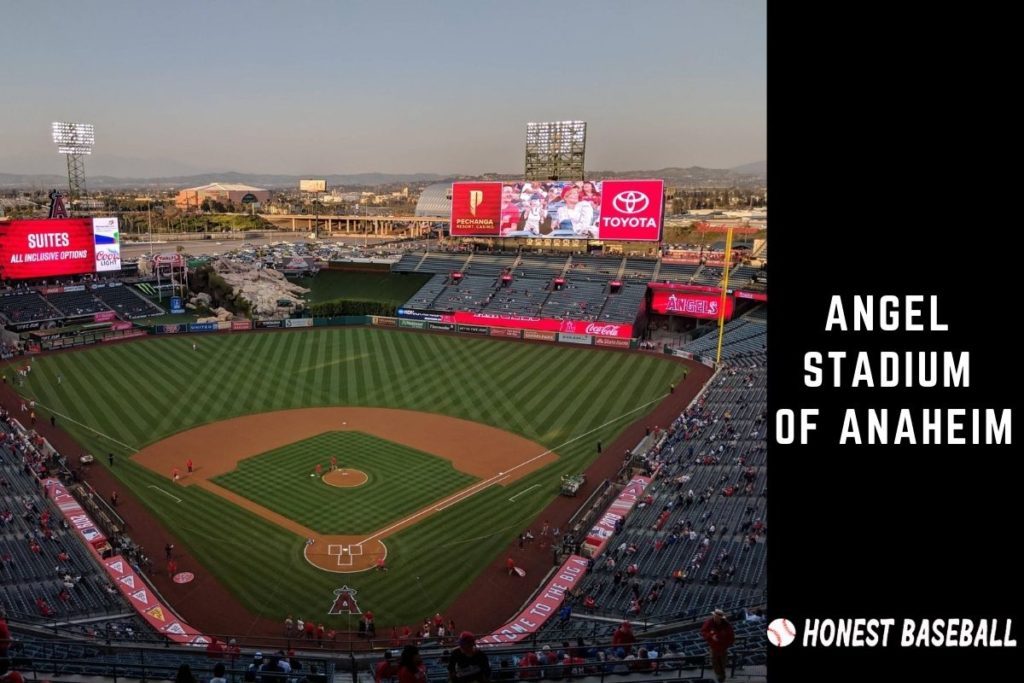
Angel Stadium demonstrates that a high-quality ballpark can be constructed using an existing building for a fraction of the cost of a brand-new one. Fenway Park, Wrigley Field, and Dodger Stadium are baseball’s three oldest operating stadiums. Angel Stadium is the fourth oldest.
Several portions of the ballpark appear like they were built in the 1980s and 1990s; this is not a nice look.
You can see the multi-purpose grandstand’s shell from the outfield interior. The decks in the left field were totally leveled. Still, the mezzanine was preserved in the center and right fields, and a new scoreboard was installed on the upper level.
Even when there are crowds of more than 40,000 people, it is astonishingly effortless to enter and exit the venue. This is the stadium’s strongest suit.
The stadium is encircled by a parking area that provides convenient access to the surrounding major roads and highways. The improvements are carried out to a high standard.
Compared to other major league parks, Angel Stadium is notable for its lack of large bars, restaurants, social areas, and accessible places to hang out. When compared to other deficits, this one is rather significant.
Around the concourse, you can tell the park is old since there is not much to do. Newer parks include Halls of Fame, eateries, and other attractions. Walking around here is reminiscent of being in a stadium for a basketball game.
Busch Stadium
Location: St. Louis, Missouri
Opened: 2006
Team: St. Louis Cardinals
Seating Capacity: 45,529
The Busch stadium holds 46,861 people and was opened by the Cardinals in 2006 with a 6-4 victory against the Milwaukee Brewers. A total of 3,407,104 people attended the Cardinals’ first season at Busch Stadium.
Just looking out over the Gateway Arch from the field is enough to separate this facility from others in baseball. One thing to remember about the Cardinals’ fanbase is that they are among the most die-hard.
Instead of overcrowding the concourse, this stadium responds to their needs by keeping the emphasis on the field. When it comes to league-wide stats, Busch Stadium is in the top half.
Because of the present ballpark’s smaller size, the Cardinals made only minor alterations to Busch Stadium II when it was demolished and rebuilt.
The Arch, one of St. Louis’ most recognizable landmarks, can be seen in the distance from the stadium’s elevated vantage point. For the first time since the 1970s and 1980s, the Cardinals chose to stray from the cookie-cutter aesthetic that pervaded many MLB ballparks at the time.
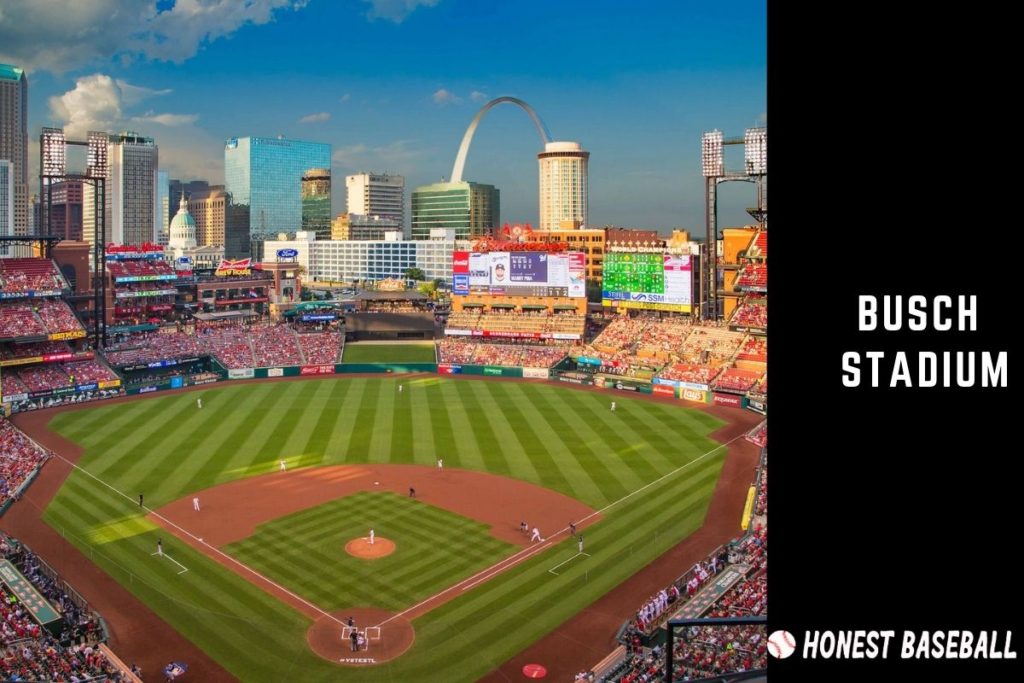
Citizens Bank Park
Location: Philadelphia, Pennsylvania
Opened: 2004
Team: Philadelphia Phillies
Seating Capacity: 43,651
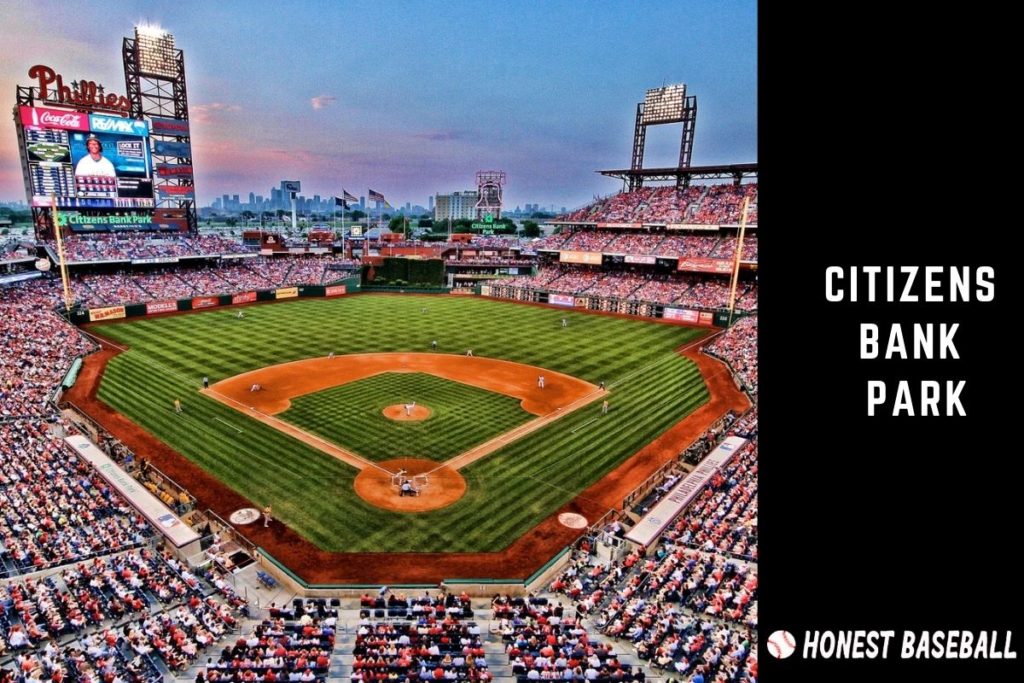
Citizens Bank Park, the Philadelphia Phillies’ home since April 2004, is a 43,500-seat ballpark with a sight of the city’s skyline and beautiful natural grass. Food Network named it one of the best places to eat while watching a game.
I have some good news for you if you plan to bring your kids to this ballpark. Citizens Bank Park is known as one of the best baseball parks for kids. It is also located a long way from Philadelphia’s business district, allowing for a spectacular perspective over the city.
This stadium is a popular tourist destination in Philadelphia. A wall in the center field that is much shorter than the other fences.
Let me summarize this stadium for you: it is amazing and cozy, with stunning views, brilliant features, and a mind-boggling number of unique elements!
Oriole Park At Camden
Location: Baltimore, Maryland
Opened: 1992
Team: Baltimore Orioles
Seating Capacity: 45,971
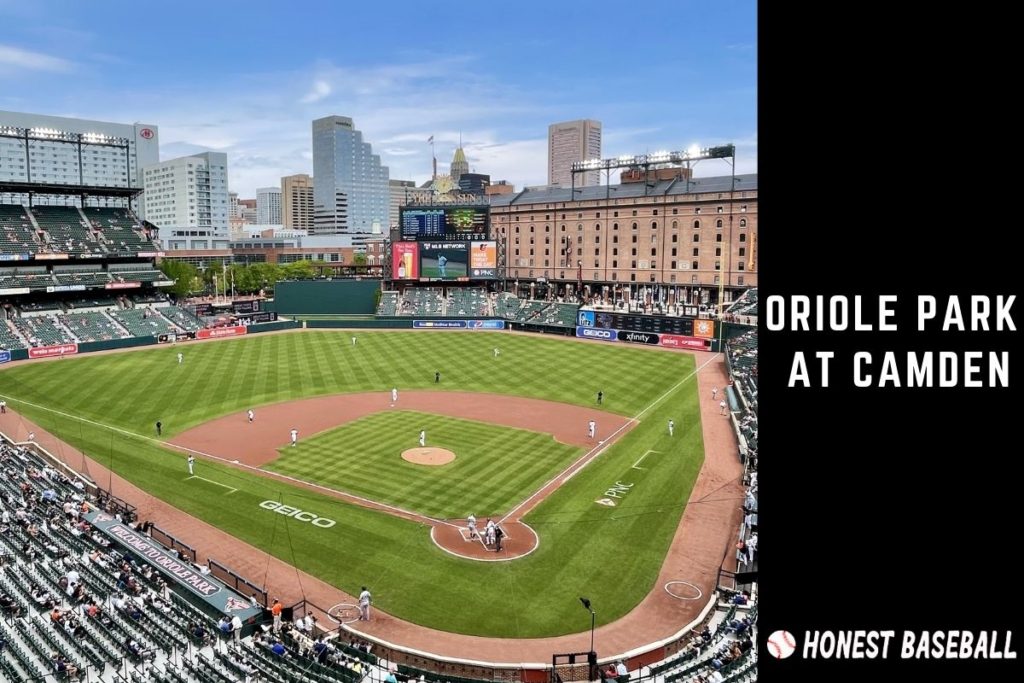
Oriole Park At Camden Yards ushered in a new age of retro-styled ballparks with its contextual architecture and modern facilities, including a crazy amount of fanfare upon inauguration.
And sure, it is common knowledge that Oriole Park should be given credit for being the source of this innovative aesthetic style. In point of fact, the importance of this stadium cannot be overstated in any way.
Even though it is beginning to exhibit signs of its age, it is nevertheless a treasure that is often copied but never reproduced.
It rises up to a height of 21 feet, any ball that is hit over it and then into the warehouses located directly across the street seems to have been struck with far greater skill. If you are looking for a great venue to catch a baseball game, Camden is the place to go!
As one of the most difficult venues to smash a home run in, expect to see less of them at Oriole Park.
The Baltimore skyline and the B&O Warehouse are also visible from your seat, as is the Inner Harbor, which is home to a plethora of delectable dining choices.
Tickets to games played by the Baltimore Orioles are among the least expensive in all of Major League Baseball. When you put it all together, it creates one of the nicest environments.
Miller Park
Location: Milwaukee, Wisconsin
Opened: 2001
Team: Milwaukee Brewers
Seating Capacity: 41,900
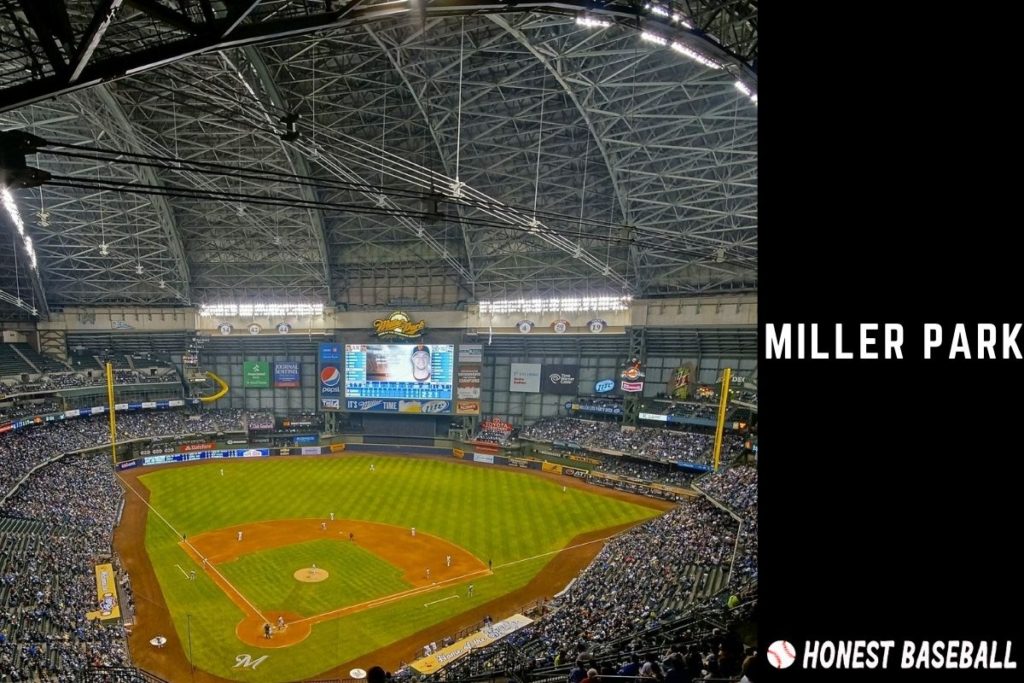
Out of all of the MLB baseball stadiums, the outside of Miller Park is widely considered to be among the most attractive. The curve, both inside and out, is something that really appeals to me.
The natural light can now penetrate the middle field thanks to the windows. I believe it is an engineering marvel.
The retractable roof, even when open, seems like confined domes. There is no getting around the fact that Miller Park’s interior makes no effort to be beautiful.
The fences intersect at odd angles, which adds unpredictability to batted balls off the wall.
Miller Park caters to all tastes. My first time at Miller Park turned out to be fantastic. Fans love to get pumped up before a match, so it was a blast.
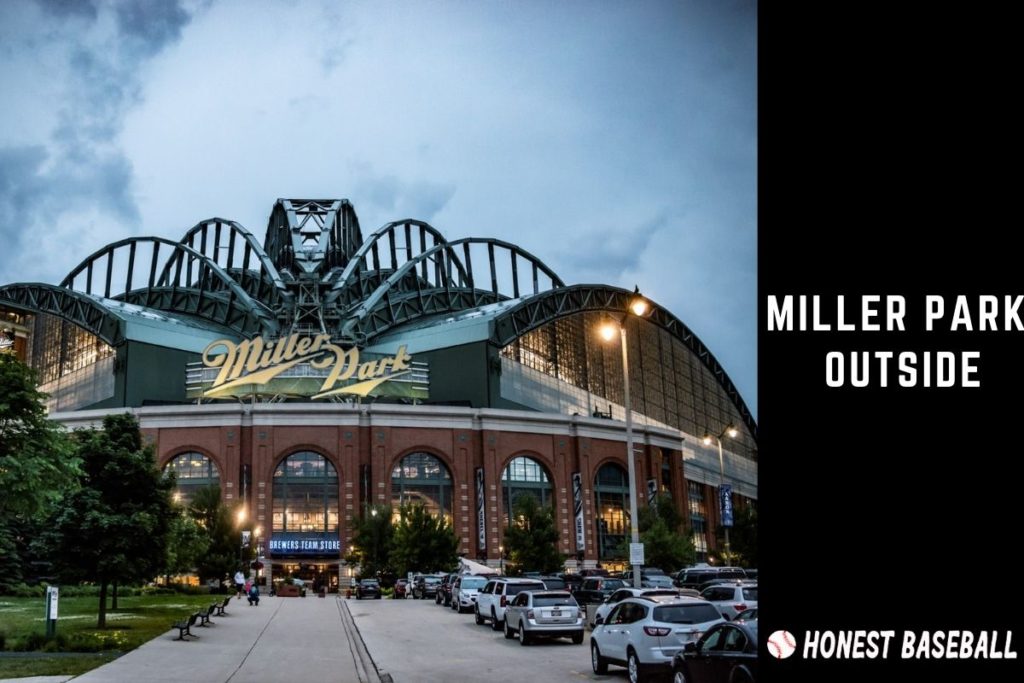
But if you want to know how is Miller Park as a ballpark, I do not have a lot of great things to say about it. Outfield design has just one purpose, which is to provide structural support for the retractable roof.
Even with the roof open, the majority of the infield seating areas are covered. Miller Park is a stadium first and a ballpark second. Some people believe it to be one of the older ballparks with the poorest design.
Citi Field
Location: Queens, New York
Opened: 2009
Team: New York Mets
Seating Capacity: 41,922
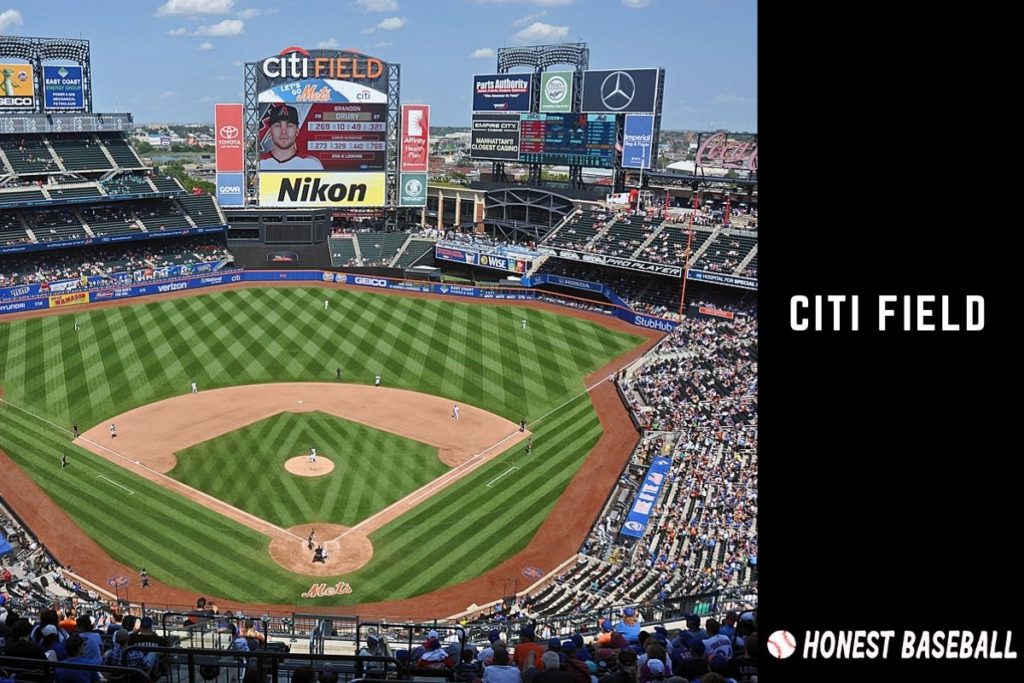
Citi Field is the home stadium of the New York Mets, the major league baseball team based in the city. Since its opening in 2009, I have always thought of Citi Field as a stadium that was conceptualized in 1999.
Shea Stadium, the Mets’ previous home, was in dire need of an improvement. Blue and orange dominate most of the stadium’s construction, giving it a nostalgic feel with a contemporary twist.
The use of escalators to connect the various concourses might make finding your way around the stadium challenge.
The exterior design of Citi Field is very stunning; nevertheless, as I have said, it seems to be out of place. The outside of the Ebbets has also been stripped of many subtle features and regional variations that made them unique.
It is one of the least appealing ones I have seen on the interior, and it definitely ranks among the worst.
Wrigley Field
Location: Chicago, Illinois
Opened: 1914
Team: Chicago Cubs
Seating Capacity: 41,649
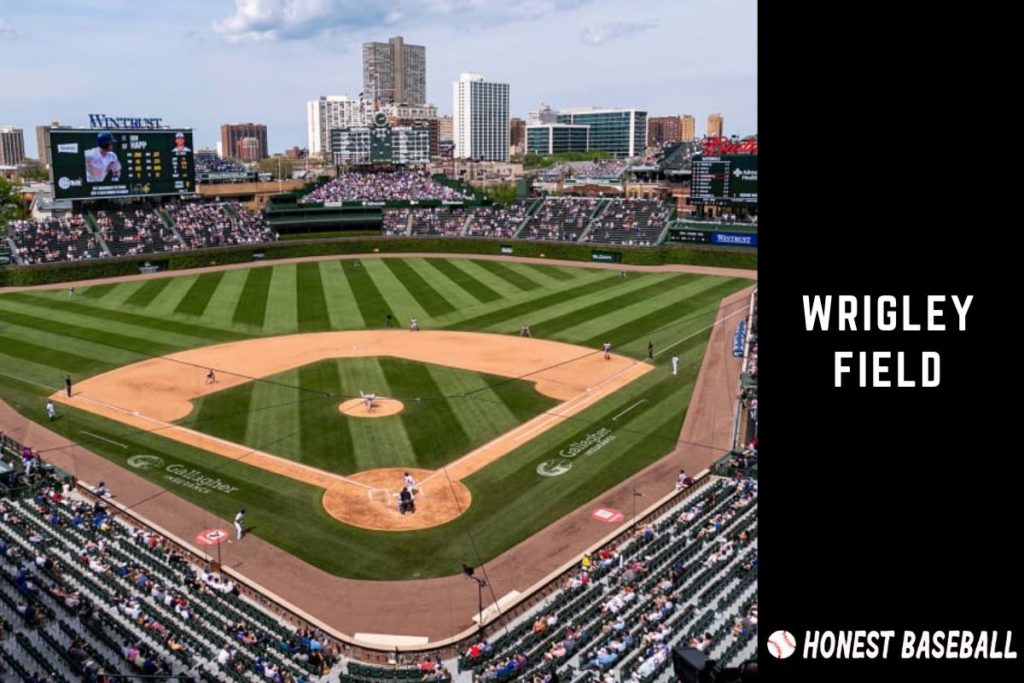
The Wrigley field is one of the earliest baseball stadiums. In its early days, the Wrigley outfield was a janky mess.
Considered one of the best local scenes in professional sports, Wrigleyville not only has a vibrant pre-and-post-game bar scene but also evokes a classic residential vibe, reminiscent of the urban neighborhoods of the early-mid 20th century. As a concept, Wrigley Field’s cozy location has contributed to its venerable and timeless image.
Wrigley Field’s exterior design is rather simple. If we talk about interior aesthetics, that’s where this stadium shines. Wrigley Field is beautiful in its own right, not just beloved for history.
Its decking structure is also functionally superior. Unlike almost every other park of its era, Wrigley avoids the common overhang issues in the lower deck, but the upper deck is still closer to the field than nearly every park in baseball today.
It’s a perfect balance, in my opinion. Unlike Fenway Park, Wrigley’s seating geometry is good as well. Those who loves baseball for a long time, love to talk about support columns, cantilevers, and field proximity, but angling the seats correctly is just as important, something that Fenway and Tiger Stadium whiffed on.
Nationals Park
Location: Washington, D.C.
Opened: 2008
Team: Washington Nationals
Seating Capacity: 41,339
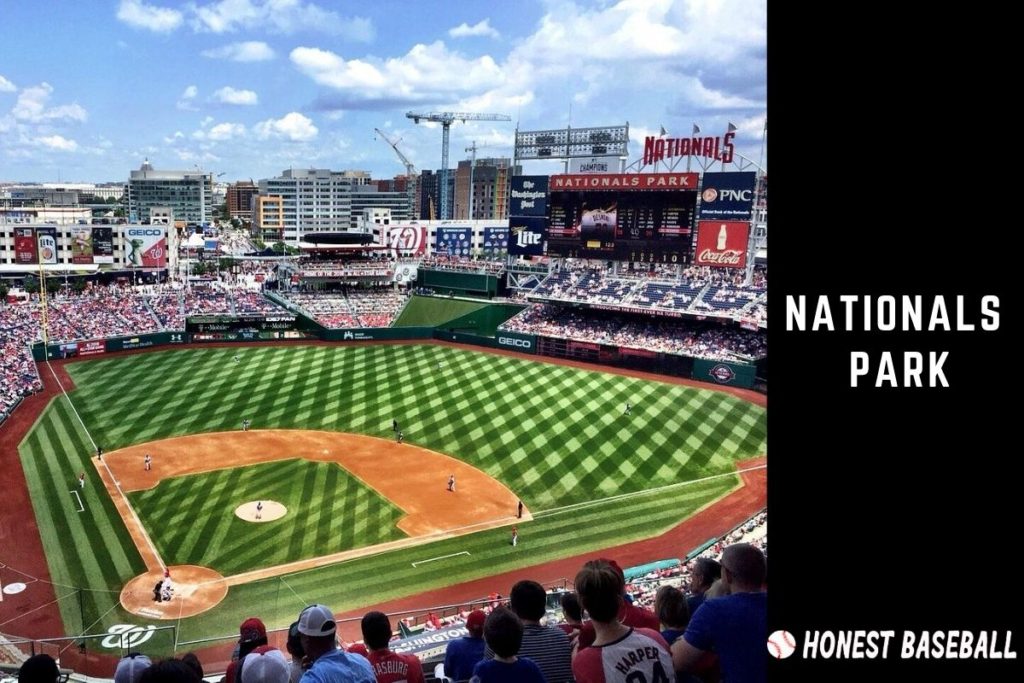
Nat’s park or National Park may not look what you have in your mind. It opened for play in 2008 with a seating capacity of 41,339. The stadium features every basic requirement to be a stadium but honestly, nothing really stands out.
It is the first LEED (Leadership in Energy and Environmental Design) stadium. Design-wise, it looked like the populous just ran out of ideas. Nationals Park was perhaps the beginning of tempering expectations for ballparks from “ballpark aficionados.”
The negative reaction was swift and harsh. Critics quickly noted Nationals Park’s lack of distinguishing features with no defining characteristics. People called the “modern” architecture bland and uninspired, without the warmth of the retro facades or the vision of the original modern ones.
So, if you have never visited a baseball ballpark before and you are planning to visit one for the first time, you better skip National park.
Oracle Park
Location: San Francisco, CA
Opened: 2000
Team: San Francisco Giants
Seating Capacity: 41,915

AT&T Park is another name for Oracle Park. With the breathtaking view of San Francisco Bay in the background, this ballpark is one of the most excellent places to enjoy a ballgame.
If you are going to complain about anything, it is the outfield proportions. It is physically impossible to have a poor experience while watching a baseball game in this stadium. It is just impossible.
Despite its small size, the concourse is filled with historical artifacts, including sculptures, a “wall of fame,” and quotations and paintings. Every accessible location, even those unsightly ramps, has been adorned with a famous historical quotation.
For example, a “Virgin America Loft” is incorporated into the arches that recall a bay front home’s warning track in the “Triples Alley” premium service idea.
The extensive range of facilities and the meticulous planning completely blew my mind. The quantity and variety of offerings at the concession stands are very impressive.
During my strolls around the concourses, I took it all in and determined that this was the best baseball field. As soon as I arrived in the right field, I realized that AT&T Park is most renowned for its location on the San Francisco coastline.
When it comes to home runs, these stadiums reflect the ideal mix of ballpark size and barriers available.
Minute Maid Park
Location: Houston, Texas
Opened: 2000
Team: Houston Astros
Seating Capacity: 41,168

Even after it opened its doors in 2000, this ballpark has maintained its status as one of the most remarkable of all time. The retractable roof of Minute Maid Park is, without a doubt, the most eye-catching aspect of this venue.
The movable roof is a dream come true for baseball fans on the go. As a result, you will not have to stress about a rain delay or sweltering heat; the staff covers the roof on hot days. However, a distinct advantage to a stadium with its roof open is that it allows you to see the Houston skyline.
Some tourists recommend going to a game on a Friday night while fireworks are being shown since the performance is particularly impressive. People interested in trying out unusual foods at ballparks will not be let down either. The park has many food options, ranging from traditional ballpark meals to nutritious salad bars.
With all due respect to the advantages, no other baseball stadium has ever baffled me like this one. Even though I, along with many other baseball enthusiasts, loathe what Minute Maid Park stands for because of its overly ridiculous features.
Truist Park
Location: Cumberland, Georgia
Opened: 2017
Team: Atlanta Braves
Seating Capacity: 41,084
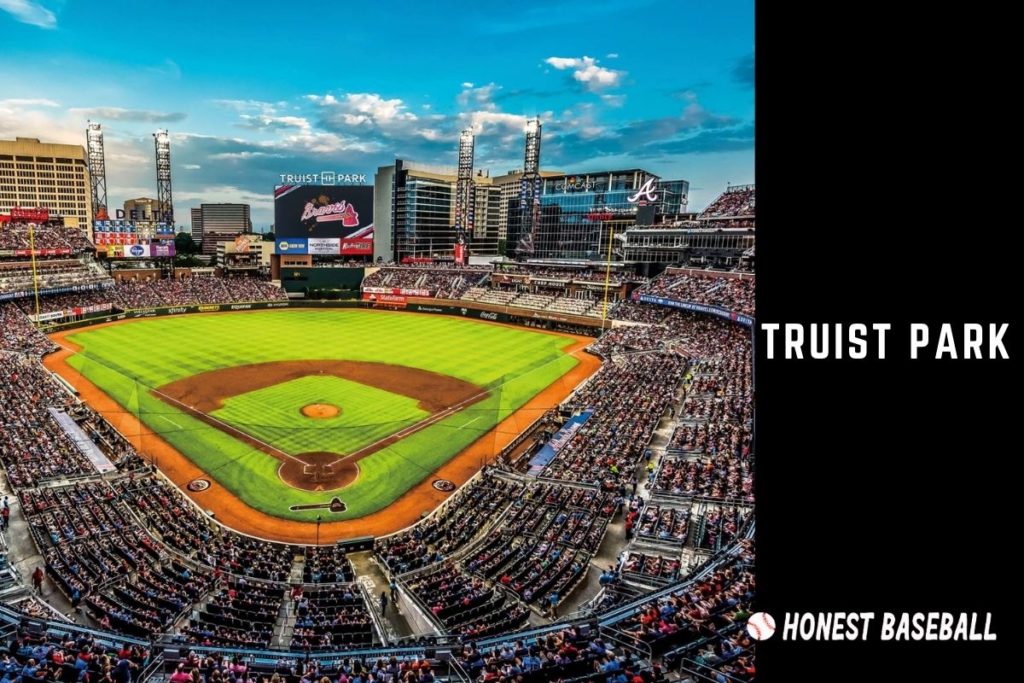
Hundreds of Atlanta Braves fans have flocked to Truist Park since the stadium opened in 2017 for their favorite MLB club. Each seat in the baseball stadium offers an expansive view of the playing field, and the venue can accommodate up to 41,000 spectators.
Atlanta Braves Games and their ballpark will make you a fan, even though you’re not already a fan. The stadium was built to accommodate all baseball fans, from diehard Braves supporters to those who just want a place to hang out with friends on a nice day.
Truist Park combines the luxuries of southern hospitality with cutting-edge technology to provide a unique fan experience.
It is clear that the fan plaza will be the most popular part of the event. Outfield seats are hidden behind a skyline that serves no purpose but to draw attention.
In addition to the advantages, the stadium has a few drawbacks. These concerns include poor cuisine, enormous people, traffic, and difficult parking.
Comerica Park
Location: Detroit, Michigan
Opened: 2000
Team: Detroit Tigers
Seating Capacity: 41,299
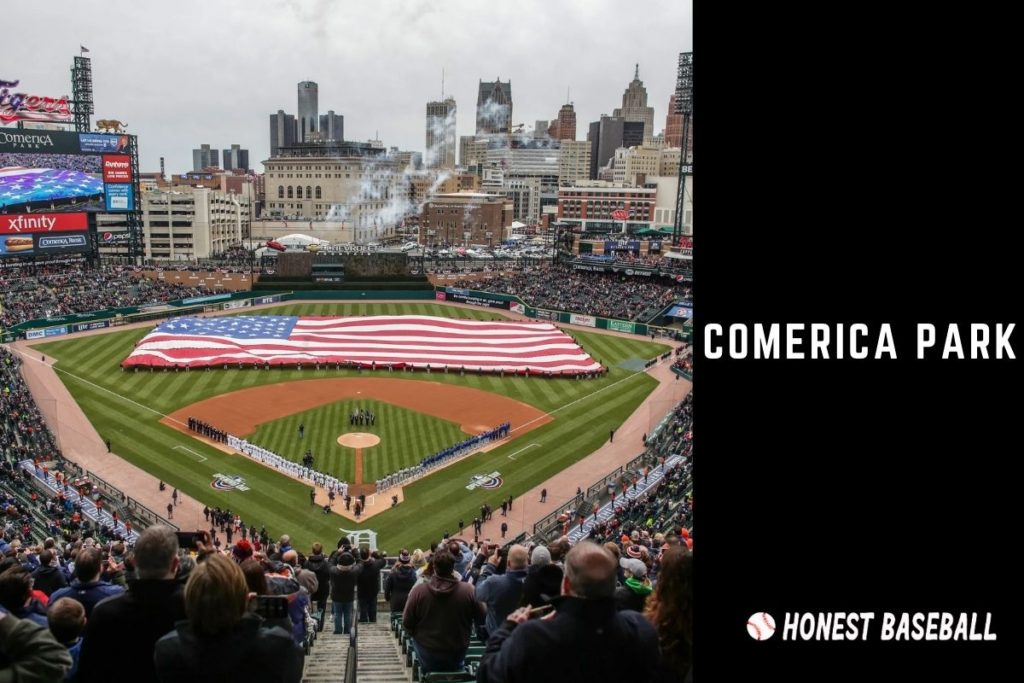
For Tigers’ supporters, Comerica Park evokes a range of feelings. The city of Detroit is home to this magnificent arena.
In contrast to the vast majority of other parks, Comerica Park provides guests with an experience. However, to really appreciate this location’s majestic nature, you will need to see it for yourself.
This stadium’s Player Intros, Statues, Flagpole, Ferris Wheel, and Time Capsule, to name a few, provide a special touch.
Even though it is not the biggest stadium in the MLB, Comerica Park provides seating options that many other major league ballparks cannot offer.
Quick Fact: Comerica Park has the largest outfield with the longest distance from home plate to the outfield wall.
Comerica Park has a seating capacity of 41,299. Therefore there is not a bad seat in the house. Furthermore, each seat provides a stunning view of the city of Detroit since there are no upper-deck seats in the outfield.
Do you know that there was a 20-foot move made toward the center-field wall? A major league record for the distance between home plate and the outfield wall continues to be Comerica Stadium’s center field. Even though Comerica does not have much room beyond the center field, its lines are a touch longer. Still, the gaps are narrower than most other ballparks in the league.
You would be astonished at how well downtown Detroit works as a background. It has a few flaws with seats, especially in the lower bowl, but few stadiums can make a spectator feel as though they are right in the center of a city as this one can.
Globe Life Field
Location: Arlington, Texas
Opened: 1994
Team: Texas Rangers
Seating Capacity: 40,300
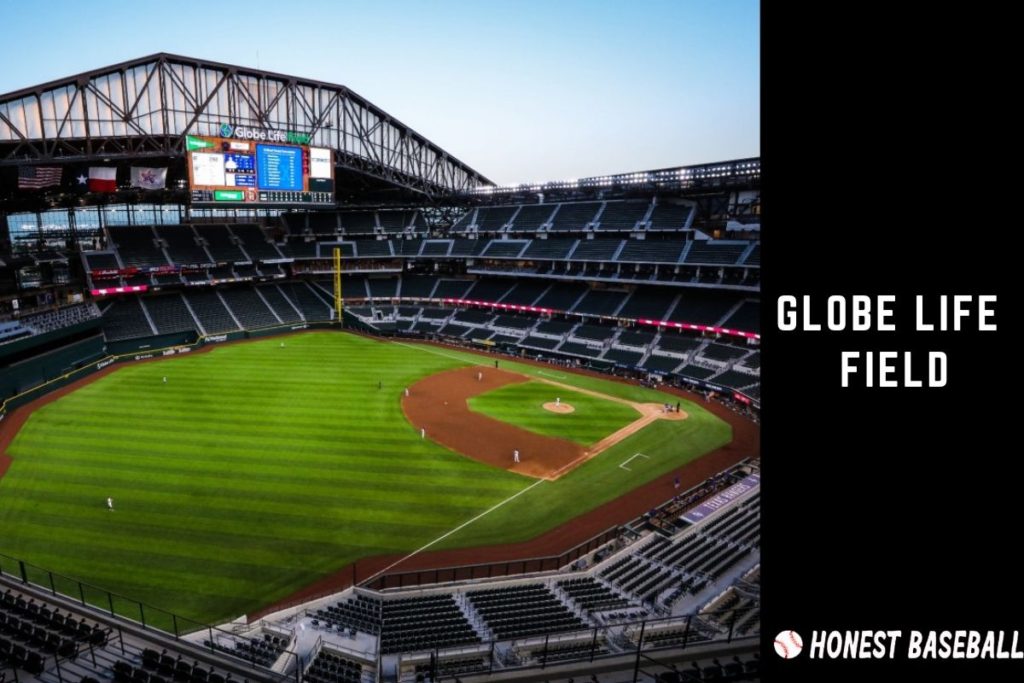
The Texas Rangers play their home games at Globe Life Field, located in Arlington in the state of Texas. The stadium has a total area of 1.8 million square feet and encompasses 13 acres.
The outfield of the new Rangers stadium does not seem to have anything particularly outstanding about it at first sight. The team, however, has hidden a wide variety of Easter eggs across the dimensions.
Globe Life Park combines aspects of traditional and historic ballparks, making it a unique MLB venue. A home run porch in the right field pays homage to the former Tiger Stadium in Detroit.
You will discover private suites in the center field area, often used by regional businesses. On the left, the 329-foot distance is a homage to Adrian Beltre’s No. 29, as is the 407-foot mark in the middle and the 326-26 mark on the far right.
It is really impressive that this is something no other baseball club has ever done, especially considering how competitive the sport is.
If you do not know how many acres is a baseball field, this post will make your notion clear.
Petco Park
Location: San Diego, California
Opened: 2004
Team: San Diego Padres
Seating Capacity: 40,209
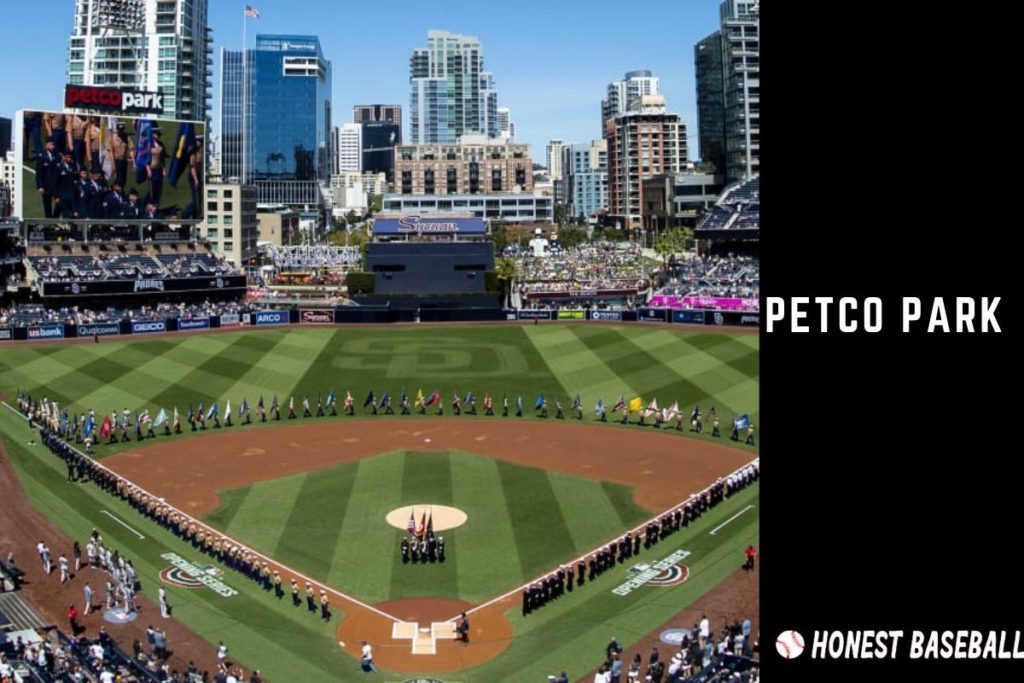
The Padres did a terrific job planning and developing Petco Park, which has both contemporary comforts and some old-fashioned charm uniquely and excitingly.
All major league baseball fans agree that Petco Park is one of the top stadiums. If you are a fan, you should visit San Diego and see a game there.
Because of the team’s recent struggles, the ticket price to see them play will be far lower than it would be for most other baseball clubs. Aside from that, it is undoubtedly one of the most entertaining sites to take in a baseball game.
It does not matter whether you are talking about the setting, the climate, the refreshments, or the stadium itself; everything about it is incredible. I get the impression that this ballpark doesn’t really receive the attention it should get.
PNC Park
Location: Pittsburgh, Pennsylvania
Opened: 2001
Team: Pittsburgh Pirates
Seating Capacity: 38,747
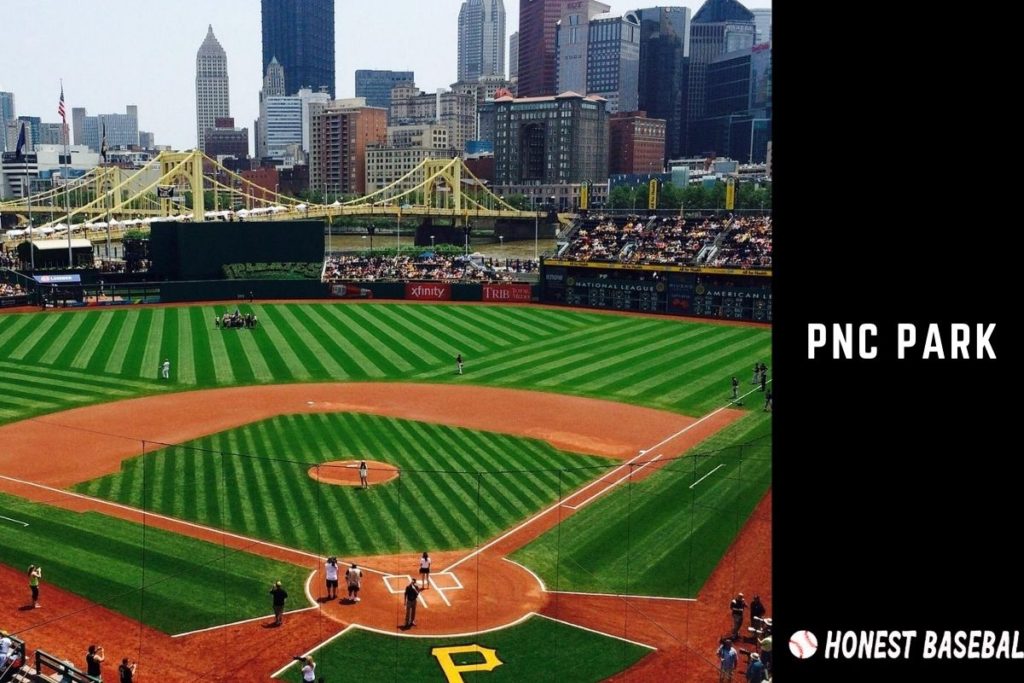
PNC Park may not be the largest stadium you have ever seen. Still, it is undoubtedly one of the most aesthetically pleasing. Located in Pittsburgh, this is one of the best spots to catch a ball game.
PNC Park is a one-of-a-kind venue for showcasing Pittsburgh. If you were to take the typical baseball fan to every MLB stadium, I believe they would choose PNC as their favorite.
If you consider the exteriors, interiors, panoramic perspective, and other intangibles, Dodger Stadium in Los Angeles can not even come close. Moreover, its beauty is so rooted in the local area.
Imagine that you traveled to Pittsburgh to see the game in sunny weather. I am at a loss for words about what could be better for a baseball fan than this?
The simplicity of the PNC park was revolutionary at its time. The compact two-deck layout, the limestone façade, and the blue chairs diverged from the classic formula.
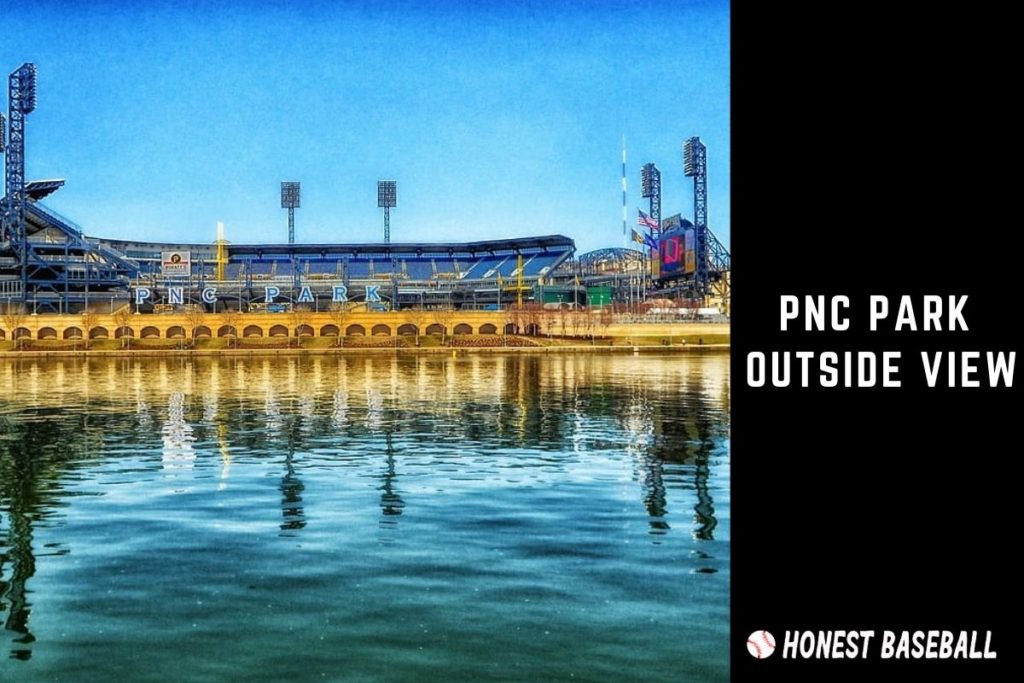
Having the river right next to the stadium is a beautiful treat. In addition to the Clemente Wall, PNC Park’s former superstars enrich the experience. Unlike any other major-league stadium, the center-field bush is a standout feature.
This ballpark’s only flaw is that the seats are much too small. This might turn a beautiful sight into a terrible one.
Kauffman Stadium
Location: Kansas City, Missouri
Opened: 1973
Team: Kansas City Royals
Seating Capacity: 37,903

The Kansas City Royals play their home games at Kauffman Stadium. Kauffman Stadium is one of the most underappreciated ballparks in the majors.
In my early days of playing the game, I made a trip to this stadium one of my favorite places to go see a game. So, this stadium has a special place in my heart.
Busch Stadium in St. Louis is the closest major league baseball stadium to Kauffman Stadium.
Previously, it took me around three or four hours of driving from my home in Kansas City to the start of the trail.
Despite being constructed at a period when many cookie-cutter and multipurpose stadiums were being up, this baseball-only stadium has held up well over time. The K was erected during the “cookie-cutter” multipurpose stadium boom of the late 1960s and early 1970s.
There are 37,903 seats at the Kansas City Royals Stadium, although there are also standing room sections available. The venue’s size can be compared to that of Fenway Park thanks to its capacity of 37 thousand people.
The Royals renovated a few years ago, removing part of the outfield fountains, but the stadium did not require much maintenance.
It is 41 years old, yet it is still a terrific site to watch a game and a tribute to excellent design.
Fenway Park
Location: Boston, Massachusetts
Opened: 1912
Team: Boston Red Sox
Seating Capacity: 37,755

Fenway Park in Boston is the oldest Major League Baseball stadium. It first opened its doors in 1912. The Green Monster is perhaps the most well-known historic building in all of the sports. It is one of just eight Major League Baseball stadiums that can not hold more than 37,731 spectators, ranking fifth in terms of seating capacity and second in terms of overall capacity.
However, the elegance of Fenway’s architecture extends far further than the left-field wall. It was constructed to make up for the shortage of available land. There is a clear distinction between centerfield and left.
Only the extraordinary power batter can send a ball into the middle of “The Triangle,” where only Jackie Bradley Jr. can catch it. The “Pesky Pole” is located in the right field and is only 302 feet away from the home plate. It is known to be effective to turn fly balls that spin into home runs.
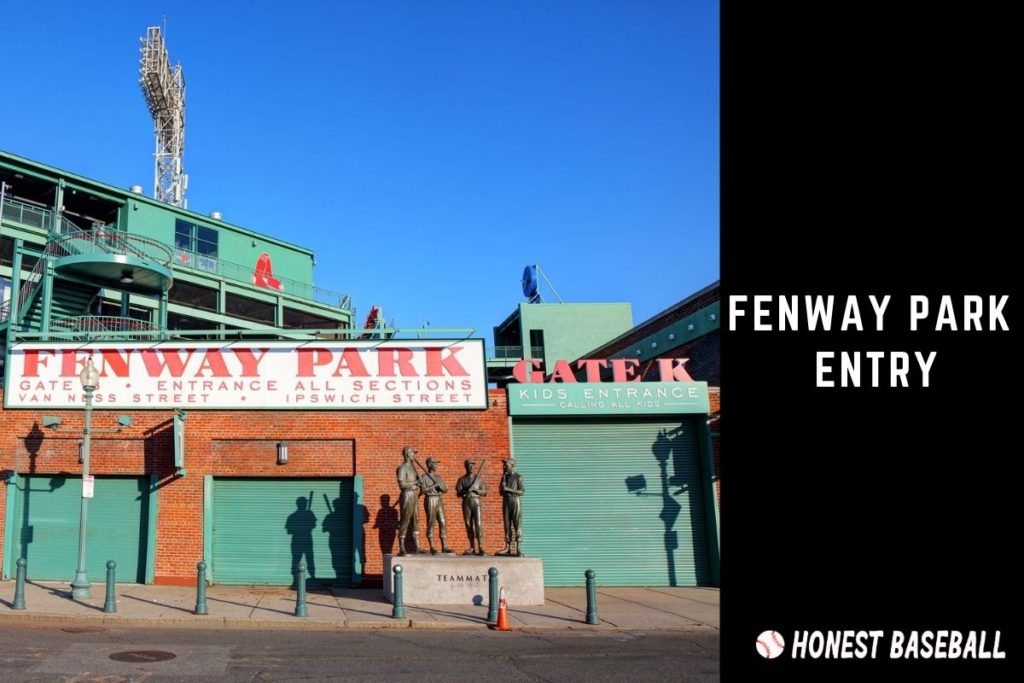
It is the atmosphere and experience, not the luxuries, that matter at Fenway Park. There are certain seats that do not have the best view. Additionally, it is an entire one-of-a-kind event that is well worth the investment. Everything is being watched over by the Green Monster.
As a non-Bostonian, you will become bored of Neil Diamond’s Sweet Caroline and so all New Englanders by nightfall. But Fenway is among the best sites to watch any athletic event, and you will be pleased you went to see a venue with such a baseball history. Every baseball fan should give it a visit at least once.
Frequently Asked Questions
Who Has the Deepest Outfield in MLB Stadium?
Minute Maid Park is the deepest center field in baseball, with a playable flagpole and hill. Houston’s Minute Maid Park is often believed to be a pitcher’s park.
What Is the Third Oldest Stadium?
Dodger Stadium, which is the home field of the Los Angeles Dodgers, is the third-oldest baseball park in MLB. The Brooklyn Dodgers were the team’s previous name in New York City before migrating to Los Angeles.
What Is the Difference Between Globe Life Park and Globe Life Field?
Greater in size than Globe Life Park, the Globe Life Field covers 1.8 million square feet. At its tallest height, the retractable roof of GLF extends 278 feet above the playing field. The outside dimensions are 785 feet wide by 815 feet long.
Are There Any Multipurpose Stadiums Left?
The popularity of multipurpose stadiums had declined by the 1990s due to the fact that they were hardly appropriate for the two sports that were often played there. Since the Rogers Centre (Former SkyDome) opened in 1989, there have been no new baseball and football stadiums built.
What Is the Average Attendance at an MLB Baseball Game?
April’s average of 25,900 attendance per game is the lowest since 2010 for MLB games in that month. And it is not only the weather that is to blame. This year’s first 25 games had an average game-time temperature of 69.6 degrees Fahrenheit, up from 60.8 degrees in 2019.
What Is average the Capacity of Biggest MLB Stadium?
Currently, Major League Baseball features 30 franchises, each of which enjoys a home-field advantage in terms of facilities. There are 42,675 seats on average at a typical ballpark.
What was the original name of the Milwaukee Brewers?
In 1969, the franchise that is now known as the Milwaukee Brewers was first established in Seattle, Washington as the Seattle Pilots. They were an expansion team for the American League (AL).
Sick’s Stadium was home to the Pilots. Only one season into their existence as the Milwaukee Brewers, the franchise moved to the city and renamed themselves Milwaukee County Stadium.
Final Words
Major League Baseball is consistently ranked among the most-watched sporting events on the planet. In 2018, there were 69.6 million spectators in attendance at live Major League Baseball games. This was the biggest attendance in the history of any professional sports league.
It is no secret that the MLB is adored, but the stadiums’ size and quality also play a role in this incredible statistic. Several clubs are already discussing stadium extensions, and in the future, we might see venues that are much bigger. The ballparks I have listed are some of the Biggest MLB Stadium. These ballparks are some of the earliest and hold a lot of history of baseball. Train yourself with a proper baseball practice plan so you can perform in one of these amazing ballparks.

Hello everyone. My name is Jason Butler, and I live in California, America. I was a professional AAA Minor League Baseball player. I lost my chance of playing MLB for injury issues, but I did not lose my love for baseball. I attended the coaching training program and am now working as a coach in a small school in San Diego.
I always love to share my experience and knowledge if that can help you. Play baseball, and stay fit.
